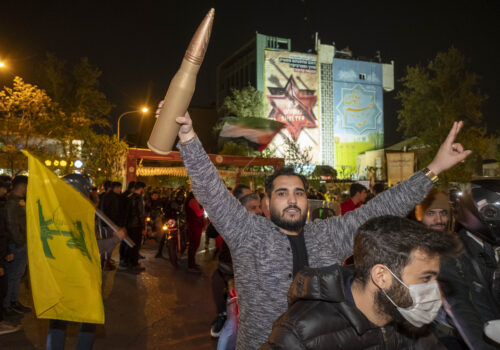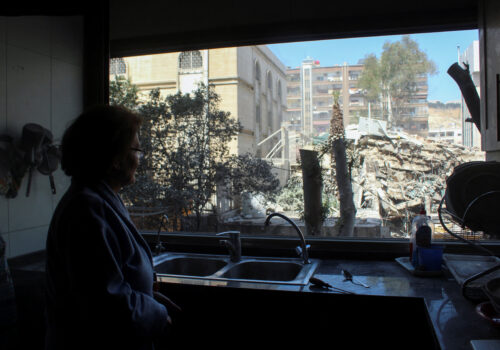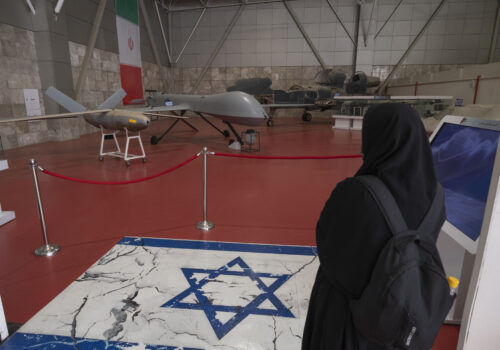Iran once had air inferiority. After its attack on Israel, it flies high.
Iran’s unprecedented April 14 attack on Israeli territory was a warning shot. It showed Tehran’s potential ability to put a dent in Israel’s formidable air superiority despite essentially its lacking a modern air force.
The direct Iranian air attack on Israeli soil was a watershed moment in the region’s steadily deteriorating security status quo. It revealed nothing new about Iran’s military capabilities. But it suggested the alarming potential for Iran to exploit Israel’s lack of strategic depth and showed a frightening willingness on the part of Tehran’s leadership to outmatch Israeli Prime Minister Benjamin Netanyahu’s recklessness. It was the first time any nation directly targeted Israel since Iraq’s Saddam Hussein launched Scud missiles against the country in 1991.
While it is highly unlikely that this attack will deter future Israeli actions against Iranian assets, it will prompt defense strategists in Washington and Israel to revise their calculations about the limits of Iran’s risk tolerance and capabilities. That, combined with pressure from the White House, may have reigned in the magnitude of Israel’s response, which came on April 19 in a series of attacks on central Esfahan province.
Some foreign policy hands described Iran’s attack on Israel as a miscalculation, a strategically and diplomatically counterproductive response to the deadly April 1 Israeli attack on the Iranian embassy compound in Damascus, Syria, which killed Islamic Revolutionary Guard Corps (IRGC) Quds Force commander Mohammad Reza Zahedi, seven other officers, and two civilians. Iran’s counterattack, some said, will rally world opinion around Israel just as it was coming under pressure over its conduct in the unfolding six-month offensive against Hamas in Gaza.
SIGN UP FOR THIS WEEK IN THE MIDEAST NEWSLETTER
But the Islamic Republic and its Supreme Leader Ayatollah Ali Khamenei see the world through a different prism. In numerous public statements, Tehran celebrated the multipronged attack on Israel as a resounding success. “We carried out a limited operation, which was commensurate with the Zionist regime’s evil acts,” IRGC commander Major General Hossein Salami said in comments reported by IRGC-affiliated Tasnim News Agency. “It could have been more widespread, but we confined the operation to that section of the Zionist regime’s facilities that had been used for attacking our embassy.”
At such moments, Iranian officials are often full of rhetoric that fails to live up to the facts. Indeed, none of the drones or missiles managed to evade Israel’s air defenses—which were assisted by the United States, United Kingdom, France, and Jordan—or inflict significant infrastructural damage.
But that may have well been by design. Israel and the United States, through European and Middle Eastern intermediaries, had warnings that the attack was coming, giving them crucial hours or days to ready air defenses.
Iran considers itself surrounded by enemies and threats, some of an existential caliber. When backed into what it perceives as a corner, as it was after the United Nations refused to condemn the attack on its Damascus embassy, it almost always favors escalation over compromise, provoking fear and uncertainty over conventional diplomacy.
In any case, none of the countries it considers friendly will punish Tehran for the attack. China, Iran’s most important patron, referred to the drone and rocket barrage as “spillover from the Gaza conflict.” Russia, too, focused on “numerous unresolved crises in the Middle East, primarily in the Palestinian-Israeli conflict” and made an unsubtle dig at Netanyahu by describing the Damascus attack as “irresponsible” and “provocative.” Beijing and Moscow will likely lead the way in watering down or vetoing any United Nations Security Council (UNSC) resolution that singles out Iran, which has turned even more strongly away from its Eurasian partners since the breakdown of the nuclear deal after the US withdrawal in 2018.
Khamenei publicly ordered retaliation after characterizing the consulate attack as an Israeli attack on Iranian soil—and thus equivalent to an attack within Iran’s borders—a proposition that is debatable at best. It is also likely that the Iranians had already designed some version of the attack that unfolded and that leadership of the IRGC and the Supreme National Security Council was eagerly looking forward to an opportunity to demonstrate its ability to shatter Israel’s sense of calm.
According to unnamed Israeli officials cited by the New York Times, the late-night attack involved 185 drones, thirty-six cruise missiles, and 110 surface-to-surface missiles launched mainly from Iran, but also from Iraq and Yemen. The attack closed schools, throttled commerce, and brought the country to a standstill during the first day of its workweek. While air defenses prevented the attack from damaging targets, one can easily imagine the impact of such a barrage if three thousand or thirty thousand weapons were launched without the benefit of a seventy-two-hour warning. Lebanon’s Hezbollah, Iran’s staunchest ally, reportedly wields an arsenal of 150,000 rockets and missiles.
Air power has been Iran’s security Achilles heel since the eight-year Iran-Iraq war (1980–1988), when Saddam Hussein bombed Iranian cities, including the capital, in a series of campaigns that traumatized a generation of Iranians. Following that war, Iran struggled to build air power and instead invested the bulk of its resources in building a ballistic missile program. Iran’s cheap combat drones were first deployed in clandestine attacks by proxies in Yemen against Saudi Arabia, and in Syria and Iraq against US forces.
Even as its militias and proxies extend Iran’s influence throughout the region, Iran has struggled to gain traction in the air, in part, due to sanctions. It wrangled with Russia for years to finally deliver and install $800 million worth of S-300 mobile anti-aircraft defense systems. Iran has been even more frustrated in its efforts to update a rickety fleet of planes consisting of a few dozen MiG-29s that it appropriated from Iraq ahead of the first US war, and a couple of dozen dilapidated 1970s F-14s Tomcats maintained with black-market parts.
Iran recently made progress on acquiring some modern aircraft, including Sukhoi Su-35 fighter jets, but it will take years before it can train pilots and field such a force. Facing years of UNSC restrictions on transfers of most weapons, it has steadily expanded both the range and accuracy of its missile and drone programs.
In a prophetic essay published last year in the journal Aether, US Air Force Major Joshua Dryden described the core of the Iran-Israel conflict “as one in which Iran seeks to deny Israel freedom of action in the air, while Israel attempts to counter these efforts.”
While Israel has largely been successful at stalling Iran’s advances, “the broader trend toward a more contested environment is one Israeli political leaders must now consider.”
Though it is difficult to glean the regime’s calculations in ordering the scale and nature of the attack, it likely considered the domestic cost and damaged morale of failing to retaliate to a strike that killed several senior security officials. Khamenei and his advisers may have felt compelled to deliver a response that would be at least as disruptive, headline grabbing, and potentially deterrent as the cruise missiles Iran launched against a US military base in western Iraq after the 2020 assassination of IRGC Quds Force commander Qasem Soleimani. While much of the discussion of the Iran-Israel conflict has been focused on proxy ground attacks, clandestine operations, and cyberwarfare, April 14 marks a new and dangerous escalation in the skies.
Borzou Daragahi is a journalist who has covered the Middle East, North Africa, and Europe for US and UK news outlets since 2002. He is also a nonresident fellow with the Atlantic Council’s Middle East Security Initiative. Follow him on X: @borzou.
Further reading
Thu, Apr 18, 2024
Jordan took out Iranian munitions over its airspace. Now it has tensions with its people and Iran.
MENASource By
A full-scale Iran-Israel war would likely harm the Hashemite Kingdom, which is squeezed between the two more powerful adversaries.
Fri, Apr 5, 2024
Most GCC states condemned the attack on the Iranian embassy complex in Syria. An escalation is what they fear most.
MENASource By
Fearful that hostilities between Israel and Iran could spiral out of control, the GCC states are keen to avoid the heat as much as possible.
Tue, Apr 2, 2024
Iranian drones have proliferated under US watch
IranSource By Daniel E. Mouton
Although the solution to stop the spread of Iranian drones is complex, it is important to note that there were plenty of warnings and time for the United States to prepare its defenses.
Image: Israeli military spokesperson Rear Admiral Daniel Hagari speaks to the media as Israel's military displays what they say is an Iranian ballistic missile which they retrieved from the Dead Sea after Iran launched drones and missiles towards Israel, at Julis military base, in southern Israel April 16, 2024. REUTERS/Amir Cohen


